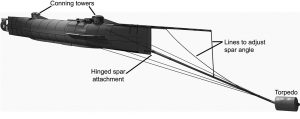
Credit: Michael Crisafulli, http://www.vernianera.com/Hunley
The Confederate vessel H.L. Hunley made history by becoming the first combat submarine to sink a Union ship during the late stages of the civil war. The Confederate army had built the 40-foot-long, 8 crewmen submarine as part of a counter effort to break the smothering blockade of the Union navy. The sub’s captain Charles Pickering managed to sink the USS Housatonic on February 17, 1864, with a submersible pole attached to a 135 lb barrel bomb, that was rammed into the Housatonic’s hull just below the waterline, causing a tremendous explosion. The Union warship went down in just five minutes but came to rest upright in 30 feet of water. Five crewmen were killed but the shallow water and the upright position allowed life boats to be launched and most of the seamen were rescued.
The submarine’s mission had been accomplished, but the ship and crew of H.L. Hunley were never heard from again. That is until 1995 when the sunken sub was found within 330 yards from the wreck of the Housatonic near Charleston Harbor in South Carolina. The vessel was raised from the ocean in 2000, with the dead skeletons of the submarine crew still at their stations nearly 150 years later. Whatever killed them left no obvious physical injuries and happened so fast that they never seemed to attempt an escape. Whats more there was no visible damage to the hull of the H.L. Hunley.
Now after an exhaustive three-year study from Rachel Lance, a Duke University Ph.D. in biomedical engineering, involving repeatedly setting blasts near a scale model of the sub, and doing a lot of calculations the answer seems clear. The crew didn’t drown or suffocate as commonly believed, but actually died from being too close to the powerful blast of their low-tech but powerful torpedo. According to the research published in PLoS One, the ensuing powerful shockwave from the explosion caused catastrophic injuries to the crewmen’s soft tissues, especially to their brains and lungs (a condition called blast lung). Dr. Lance calculates the probability of instantly fatal lung trauma to be at least 85 per cent for each of the Hunley crewmen. She theorizes that the unmanned sub was pulled out on a falling tide and slowly took on water before sinking.
“This is the characteristic trauma of blast victims, they call it blast lung”, said Dr. Lance.
“You have an instant fatality that leaves no marks on the skeletal remains. Unfortunately, the soft tissues that would show us what happened have decomposed in the past hundred years.”










